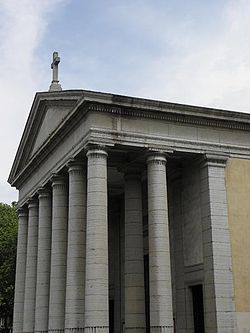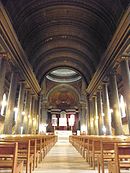- Église Saint-Pothin
-
Église Saint-Pothin 
Facade of the church
Basic information Location Lyon, France Affiliation Roman Catholic District 6th arrondissement of Lyon Architectural description Architect(s) Christophe Crépet Architectural type Church Architectural style Neoclassicism Completed 1843 Specifications The Église Saint-Pothin (English: Church of Saint Pothinus) is one of the religious buildings of Lyon, on the left bank of the Rhône, in the 6th arrondissement of Lyon, on the Place Edgar Quinet. By order of 2 May 2007, the whole church was included in the supplementary inventory of monuments historiques.[1]
Contents
History
The creation of the parish of St. Pothin and the construction of the church became part of the urban development of Les Brotteaux district from the late 18th century. The progressive urbanization of the area followed a plan made by Jean-Antoine Morand (1727-1794), an architect in Lyon, and Saint-Pothin was one of the structural elements of the new plot. A chapel was opened in 1818, but Les Brotteaux district decided to create of a branch of La Guillotière district placed under the patronage of St. Pothin under the pressure of the notables, not after a special concern of the Archbishop of Lyon.[2] The royal ordinance of 21 June 1826 allowed this project to be materialized, thus facilitating the project of church construction and financing. The parish boundaries were established in 1827, however. Canuts smashed the doors of the old church in 1831.[3]
In 1835, the Hospices Civils de Lyon made a gift of land[4] and a contest was organized by the city fathers of La Guillotière. Christophe Crépet (1807-1856), Lyon architect of La Guillotière and former student of the École des Beaux-Arts de Paris, was to be the winner. He made a neoclassical project, that was partially carried out from June 1841 to 1843, as the budget, largely undervalued, was tripled. For economic reasons, this led to an adjournment of the church decoration (many statues of saints were planned, but the project was finally abandoned)[3] and the use of inferior materials, which begat architectural disorder.
The church was opened on Christmas Day of 1843.
Architect of Lyon city Tony Desjardins in 1867, then architect Claudius Porte in 1874 and 1876-1877, directed restoration campaigns.
Architecture
This church has a neoclassical style and looks like a Greek temple.[5] It has a Latin cross form, and its facade has a Doric portico, topped by a triangular pediment,[1] and many Doric columns.[6] Above the six colomns of the facade, there are a frieze and a triangular pediment with a cross.[3]
In the interior, the fresco of the dome was conducted in 1893-1894 by Étienne Couvert[1] (1856-1933) and depicts the Virgin and the twelve apostles, and there is a glass made by Lucien Bégule,[1] representing the Holy Spirit as a dove. The stained glass windows were made by Lucien Bégule's son, Émile (1880-1972), showing the founders of the Church of Lyon (St Irenaeus, St Polycarp, St Blandina and St Pothinus) and that of France (St Genevieve, St Clotilde).There is also a 1656 painting depicting St. Paul in front of the Areopagus, which was previously kept at Notre-Dame de Paris.[6]
The organ is placed in the apse and the nave is lined aisles.[3]
Stained glass windows made by Bégule
References
- ^ a b c d "Monuments historiques — Église Saint-Pothin" (in French). Mérimée. http://www.culture.gouv.fr/public/mistral/merimee_fr?ACTION=RETROUVER&FIELD_1=cmer1&VALUE_1=lyon&FIELD_2=cmer4&VALUE_2=%e9glise&FIELD_3=cmer5&VALUE_3=&FIELD_4=AUTR&VALUE_4=&FIELD_5=TOUT&VALUE_5=&FIELD_6=titre%20courant&VALUE_6=&FIELD_7=date%20protection&VALUE_7=&FIELD_8=DOSURLP&VALUE_8=%20&NUMBER=1&GRP=0&REQ=%28%28lyon%29%20%3aLOCA%2cPLOC%2cINSEE%20%20ET%20%20%28%28%e9glise%29%20%3aDENO%2cPARN%2cREMA%2cACTU%2cPDEN%2cMHPP%20%29%29&USRNAME=nobody&USRPWD=4%24%2534P&SPEC=9&SYN=1&IMLY=&MAX1=1&MAX2=100&MAX3=100&DOM=Tous. Retrieved 21 September 2010.
- ^ Saunier, Pierre-Yves. L'église et l'espace de la grande ville au XIX° siècle: Lyon et ses paroisses. (in French) (pdf). Revue Historique (Archives ouvertes) 288: 13. http://halshs.archives-ouvertes.fr/docs/00/00/35/13/PDF/revue_historique_paroisses.pdf. Retrieved 21 September 2010.
- ^ a b c d Jacquemin, Louis (1985) (in French). Histoire des églises de Lyon, Villeurbanne, Vaulx-en-Velin, Bron, Vénissieux, Saint-Fons (2nd edition ed.). Lyon: Élie Bellier. pp. 271–74. ISBN 2-904507-07-X.
- ^ Pelletier, André; Rossiaud, Jacques; Bayard, Françoise; Cayez, Pierre (Novembre 2007) (in French). Histoire de Lyon des origines à nos jours. Éditions Lyonnaises d'Art et d'Histoire. p. 742. ISBN 978-2841471904.
- ^ "Église Saint-Pothin" (in French). Rhône Tourisme. http://www.rhonetourisme.com/fr/Culture-histoire/Architecture/Eglises-monuments-religieux/Liste-complete/Eglise-Saint-Pothin-69386-Lyon-Tourisme-et-Congres. Retrieved 21 September 2010.
- ^ a b Eberhard, Pierrick (2010) (in French). Lyon et ses parcs et jardins — Grand Lyon, département du Rhône. Lyon: Éditions Lyonnaises d'Art et d'Histoire. p. 70. ISBN 2841472185.
External links
6th arrondissement of Lyon Quarters Les Brotteaux · Cité-Internationale · Vitton-Thiers · Foch · MassénaStreets Boulevard des Belges · Rue Duguesclin · Rue Garibaldi · Rue Tronchet · Rue de Créqui · Rue de VendômeMonuments Église Saint-Pothin · Gare des Brotteaux · Interpol · Lycée du Parc · Musée d'art contemporain de Lyon · Palais des congrès de LyonParks Jardin botanique de Lyon · Parc de la Tête d'OrTransports Categories:- 6th arrondissement of Lyon
- Churches in Lyon
- Religious buildings completed in 1843
- Neoclassical architecture in France
- Official historical monuments of France
Wikimedia Foundation. 2010.





